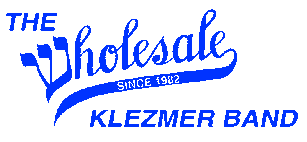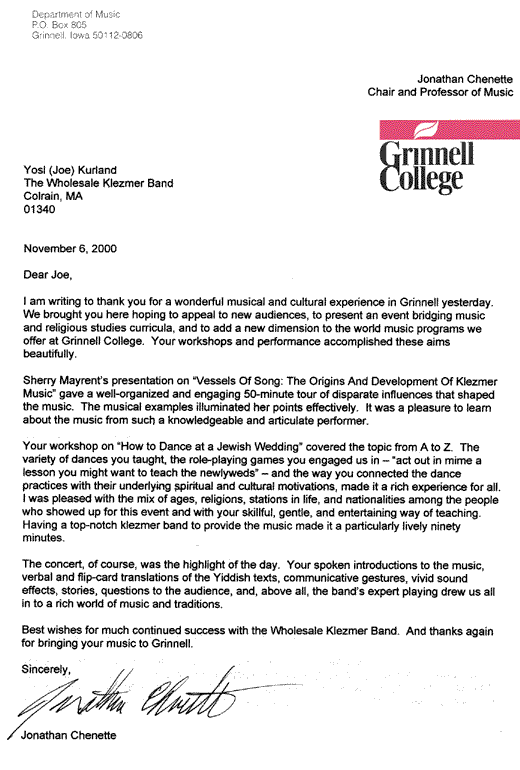
Workshops and Educational Programs
See also: School Programs
 |
Workshops and Educational ProgramsSee also: School Programs |
Traditional Jewish Wedding Dance serves three ritual purposes: fulfillment of the Mitzve--to dance and entertain the bride and groom, to teach the couple lessons about their relationship, and to knit two communities, the bride's side and the groom's side, into one. Besides that, it's great fun for all involved. It's also easy. And you don't have to restrict yourself to weddings to do these dances, now you'll know what to do when you go to your next klezmer concert. At an evening concert/dance, The Wholesale Klezmer Band will lead the whole group in those dances, with the people who had attended the workshop earlier in the day being a core of somewhat experienced dancers able to help the others along.
| Click here to see what the organizer of the KlezmerQuerque festival had to say about our workshops. |
How to do a Jewish Wedding is an expansion of the above workshop to include all the musical elements of a traditional Ashkenazic Jewish wedding including music for the kale bazetsn (seating/greeting of the bride), khosn's tish (groom's table), interrupting the groom as he attempts to deliver a droshe (learned talk), badkhones (the wedding singer), music for the khupe (at the ceremony), music for the reception, and nusakh (traditional chant melodies) for the khupe and sheva brokhes (seven blessings). This workshop is especially useful for klezmer band members.
You can also introduce all the elements of a traditional Ashkenazic Jewish wedding to your community by holding a model wedding with the Wholesale Klezmer Band. This can be a wonderful educational, social, and even a fund-raising event for your congregation. A couple from your organization volunteers to be the bride and groom, others agree to play the parts of the parents. Hire a local caterer to prepare a meal (good publicity for the caterer), and, in cooperation with your rabbi, we'll stage the rest.
Workshop Leaders: Yosl (Joe) Kurland and Khaye (Peggy) Davis
with members of the Wholesale Klezmer Band
Traditional Jewish prayer chanting makes use of nusakh, the building blocks of melody. There are nuskhoyes for weekdays, for Shabbos and festivals, for weddings, and for the High Holy Days. Each of these makes use of a musical mode (like a scale). For example, one of the best known Jewish modes, Ahava Rabo (major scale with a flatted second) is familiar to many in the melody of Avinu Malkeynu during the High Holy Days. Adoshem Molokh mode (major scale with a flatted 7th) is used for part of the Shabbos Ma'ariv service and the seven blessings sung at a wedding. Depending on the time of year we will learn to chant along with the ba'al tfile for a variety of services.
In a variation of the Nusakh workshop, Learning Service for Shabbos Morning, Yosl leads the congregation through a selection of Shabbos morning prayers with attention to understanding the words and making the music express their meaning. Yosl learned from his teachers that a balanced service contains nusakh (chant with no fixed meter), song for prayers that were written in metrical poetry, and khazanic interpretation. In this learning service, he teaches how to put together nusakh elements to chant prayers, as well as interspersing some prayers sung as congregational songs and chanting a khazanic solo within the context of a congregational chant of the kedusha. Yosl loves to present this workshop in co-operation with your congregation's rabbi who can give a drosh or d'var Torah (talk on a Torah topic).
Workshop Leader: Yosl (Joe) Kurland
Learn some Yiddish vocabulary through songs, stories and poetry, and learn how Yiddish words and expressions reflect Jewish ways of thinking and acting. If you don't have a whole week or weekend for an extended immersion in Yiddish, this workshop is a quick way to taste the flavor of Yiddish, its poetry and it's importance in understanding ourselves. For example, how does a Jew count people? We don't. We figure out how many people there are without counting them, and it's built-in to the Yiddish language. Find out why, and learn a song to help remember.
Yosl and Khaye teach Yiddish to all ages in workshops that can be just a taste in a couple of hours to an intensive weekend, or an extended course. One of the easiest ways of learning vocabulary and grammar is to learn songs that are examples. When you memorize a song, you memorize an example of sentence structure. When you learn a song or story's meaning, you have an easy way to remember the meaning of the vocabulary that appears in it. Stories and dialogues begin in mostly English with significant Yiddish words thrown in and grow to become all Yiddish through the course of a longer program. Vocabulary building games using word/picture cards add to the fun. And through it all, you get to learn about the culture of our thousand year old Ashkenazic civilization of which Yiddish was the primary spoken language.
Workshop Leaders: Yosl (Joe) Kurland and Khaye (Peggy) Davis
Workshop Leaders: Yosl (Joe) Kurland and Khaye (Peggy) Davis
with members of the Wholesale Klezmer Band
With so few people left who understand Yiddish today, Yosl Kurland sings and writes Yiddish songs because the Yiddish language helps him express what he has to say better than any other language. Although not a native Yiddish speaker, Yosl says that Yiddish has words with "yikhes," or lineage. In other words, since Yiddish vocabulary comes from both the holy tongue of Hebrew, and from various secular languages, every word carries associations with it that bring layers of meaning beyond their simple definitions. Yiddish songs, language and literature contain cultural treasures, express particularly Jewish ways of looking at the world, life, and our relationship with both the worldly and the holy.
Yosl will talk about, translate and perform songs that have been significant in his love affair with the Yiddish language well as his own Yiddish songs and poetry.
Workshop Leader: Yosl (Joe) Kurland
A look at how laughing with tears is fundamental to the Jewish outlook on life using Yiddish song and story, and the traditional music of prayer for examples.
An example: Ashrei is a prayer whose opening three lines are about happiness. Ordinarily Ashrei is chanted with the nusakh of the time of day and week. At the opening of Neileh near the end of Yom Kippur, Ashrei is sung with a nusakh sad enough to break your heart. The irony of pairing a happy prayer with a sad melody is typical of the Jewish outlook on life. We are commanded to rejoice even if we have reason to be sad (v'samakhto b'khagekho) and we recall the brokenness of the world at the most joyous of occasions, symbolized by breaking a glass at a wedding.
Another example: This Yiddish wedding song sung by a badkhn (wedding singer):
Khosn kale, mekhutonim un fraynt,
hert vos es darshnt der badkhn haynt.
Oy haynt is a tog fun glik un fun freyd,
oy es tsitert der fidl un es khlipet di fleyt,
oy es tsitert der fidl un es khlipet di fleyt.
Bride and groom, relatives and friends,
Here's a lesson the badkhn has for you today
Today is a day of happiness and joy without end,
but the fiddle is trembling and the flute sobs away.
Here sits the bride, beautiful as the day,
And here is the fiddle, what's it got to say?
Oh, beauty is beauty, but it soon fades away.
So says the fiddle, now flute speak if you may.
Beauty's but a shadow, and happiness too,
Beauty soon fades, won't come back into view,
Thus says the badkhn, as he sheds a tear too.
Here sits the groom, clothed like a king,
And the bride in her gown like the queen of the day.
Relatives and guests, in your honor I sing,
And over us all, the flute still sobs away.
(English translation copyright ? Yosl (Joe) Kurland 2002)
It is said that the deepest emotions come from the meeting of opposites. For this workshop we will examine Jewish melodies, prayers, songs and customs that demonstrate the Jewish marriage of laughter with tears.
Workshop Leader: Yosl (Joe) Kurland
Presenter: Peggy Davis
Peggy H. Davis Calligraphy
Workshop Leader: Peggy Davis
A musical introduction to Yiddish culture for anyone who likes to sing, or just to listen, this is a chance to experience treasures of Jewish folk and artistic expression through a wide range of Yiddish song. Tears and laughter, Jewish values and social justice, love and lullabyes are all included in the repertoire.
Workshop Leaders: Yosl (Joe) Kurland and Khaye (Peggy) Davis
Whether you are a professional singer or just love to perform, whether you are fluent in Yiddish or know only a few words, this workshop is for people who would like to put some effort into developing their performance of Yiddish song. Particular attention will be paid to pronunciation, phrasing, nuances of meaning and Yiddish singing style. We will also work on how to bring out the meaning and characterization of each song. Participants are encouraged to choose songs in advance and become familiar with words and melody so that they may receive the maximum benefit of coaching. Bring your recording devices.
Workshop Leader: Yosl (Joe) Kurland
 For more information and to book workshops and educational programs with the Wholesale Klezmer Band and calligrapher Peggy Davis, call Yosl (Joe) Kurland or Peggy at 413-624-3204 or email us at
wkb@ganeydn.com
For more information and to book workshops and educational programs with the Wholesale Klezmer Band and calligrapher Peggy Davis, call Yosl (Joe) Kurland or Peggy at 413-624-3204 or email us at
wkb@ganeydn.com
Click here to go back to table of contents
This website has been written and designed by Yosl (Joe) Kurland with graphic elements created by Peggy Davis and Yosl (Joe) Kurland. We welcome your comments on the contents and design of the site. Joe and Peggy are available to design your web page too. Please address inquiries and comments to the webmaster.